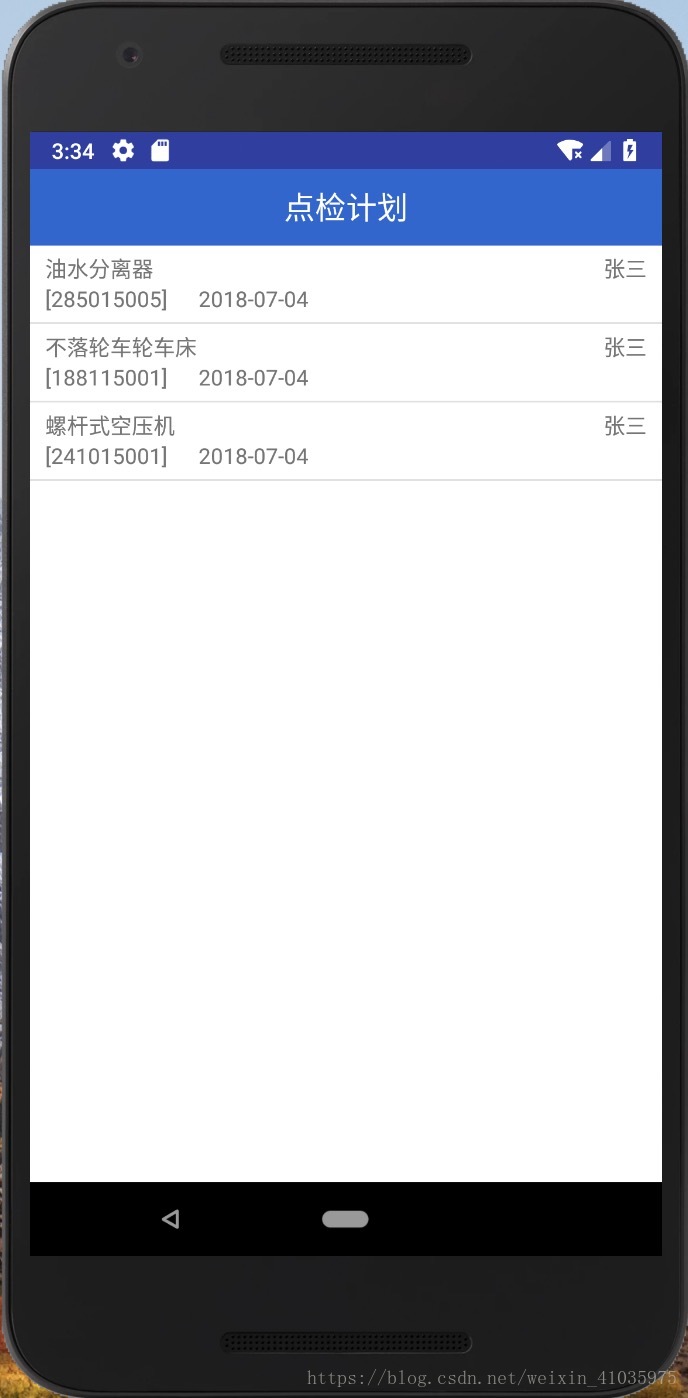最近在做一个Android的项目,闲暇之余写写博客。一方面供大家一起学习,另一方面作为以后再次用到的时参考记录一下。博客没什么顺序,完全是做到哪里遇到了问题就写一下。
现在我们来做一个点检计划列表,要做点检列表分三个部分:Spotcheck类、列表适配器、创建列表。所有的列表都分这三个部分。
建立Spotcheck类,代码如下,很简单不做解释了,变量意义看注释
public class SpotCheck { private String equipment_name;//设备名称 private String equipment_id;//设备id private String order_date;//生成订单的日期 private String checker_name;//点检人姓名 public SpotCheck(String equipment_name,String order_id,String order_date,String checker_name){ this.equipment_name = equipment_name; this.equipment_id = order_id; this.order_date = order_date; this.checker_name = checker_name; } public String getEquipment_name() { return equipment_name; } public String getOrder_date() { return order_date; } public String getChecker_name() { return checker_name; } public String getOrder_id() { return equipment_id; } }
建立适配器,代码如下,
public class SpotCheckAdapter extends ArrayAdapter<SpotCheck> { private int resourceId; public SpotCheckAdapter(Context context, int textViewResourceId, List<SpotCheck> objects){ super(context,textViewResourceId,objects); resourceId = textViewResourceId; } @NonNull @Override public View getView(int position, @Nullable View convertView, @NonNull ViewGroup parent) { SpotCheck spotCheck = getItem(position);//获取当前项的SpotCheck实例 View view; //判断是否加载过布局 if (convertView == null){ view = LayoutInflater.from(getContext()).inflate(resourceId,parent,false);//加载传入的布局 }else { view = convertView; } //获取实例 TextView equipment_name = (TextView) view.findViewById(R.id.equipment_name); TextView checker_name = (TextView) view.findViewById(R.id.checker_name); TextView order_id = (TextView) view.findViewById(R.id.equipment_id); TextView order_date = (TextView) view.findViewById(R.id.order_date); //设置内容 equipment_name.setText(spotCheck.getEquipment_name()); checker_name.setText(spotCheck.getChecker_name()); order_id.setText(spotCheck.getOrder_id()); order_date.setText(spotCheck.getOrder_date()); //返回布局 return view; } }
解释一下构造器SpotCheckAdapter的参数,context顾名思义上下文也就是这个适配器用在哪个activity里,textViewResourceId是列表每一行所对应的xml格式,最后一项很容易是列表内容项。
if (convertView == null){ view = LayoutInflater.from(getContext()).inflate(resourceId,parent,false);//加载传入的布局 }else { view = convertView; }
这一部分是为了判断是否已经加载布局,如果加载过布局就用以前的布局,如果没有加载就加载新的布局。这样可以大大节省加载布局消耗的资源,在列表项多并且列表快速滚动的时候这几行代码是必要的。
点检类和适配器类都建好了,最后一步就该实现了。
首先,把点检条目的格式定好,代码如下,
<?xml version="1.0" encoding="utf-8"?> <LinearLayout xmlns:android="http://schemas.android.com/apk/res/android" android:layout_width="match_parent" android:layout_height="50dp" android:orientation="vertical" android:gravity="center" android:paddingLeft="10dp" android:paddingRight="10dp"> <LinearLayout android:layout_width="match_parent" android:layout_height="wrap_content" android:orientation="horizontal"> <TextView android:layout_width="wrap_content" android:layout_height="wrap_content" android:id="@+id/equipment_name" /> <TextView android:layout_width="match_parent" android:layout_height="wrap_content" android:id="@+id/checker_name" android:gravity="right"/> </LinearLayout> <LinearLayout android:layout_width="match_parent" android:layout_height="wrap_content"> <TextView android:layout_width="wrap_content" android:layout_height="wrap_content" android:text="["/> <TextView android:layout_width="wrap_content" android:layout_height="wrap_content" android:id="@+id/equipment_id"/> <TextView android:layout_width="wrap_content" android:layout_height="wrap_content" android:text="]"/> <TextView android:layout_width="wrap_content" android:layout_height="wrap_content" android:id="@+id/order_date" android:layout_marginLeft="20dp"/> </LinearLayout> </LinearLayout>
然后,把点检列表的格式定好,代码如下,
<?xml version="1.0" encoding="utf-8"?> <FrameLayout xmlns:android="http://schemas.android.com/apk/res/android" android:layout_width="match_parent" android:layout_height="match_parent" android:orientation="vertical" android:id="@+id/spot_check_list" android:background="#ffffff"> <LinearLayout android:layout_width="match_parent" android:layout_height="match_parent" android:orientation="vertical"> <include layout="@layout/title_spot_check_list"/> <ListView android:layout_width="match_parent" android:layout_height="match_parent" android:id="@+id/list_spotcheck"> </ListView> </LinearLayout> </FrameLayout>
这里include了一个布局,用于给定标题栏,这里不是重点就不做解释了。
最后,建立Activity就完成了,代码如下,
public class SpotCheckListActivity extends AppCompatActivity{
//定义数据
private String[] equipment_name = {"油水分离器","不落轮车轮车床","螺杆式空压机"};
private String[] order_id = {"285015005","188115001","241015001"};
private String[] oder_date = {"2018-07-04","2018-07-04","2018-07-04"};
private String[] checker_name = {"张三","张三","张三"};
//建立点检列表
private List<SpotCheck> spotCheckList = new ArrayList<>();
@Override
protected void onCreate(@Nullable Bundle savedInstanceState) {
super.onCreate(savedInstanceState);
setContentView(R.layout.activity_spot_check_list);
//隐藏系统自带的actionBar,对应include使用
ActionBar actionBar = getSupportActionBar();
if (actionBar != null){
actionBar.hide();
}
initSpotCheck();
SpotCheckAdapter adapter = new SpotCheckAdapter(SpotCheckListActivity.this,R.layout.spotcheck_item,spotCheckList);//适配器实例
ListView listView = (ListView) findViewById(R.id.list_spotcheck);//创建列表实例
listView.setAdapter(adapter);//适配器传递给listView
listView.setOnItemClickListener(new AdapterView.OnItemClickListener() {
@Override
//列表点击事件
public void onItemClick(AdapterView<?> adapterView, View view, int position, long id) {
SpotCheck spotCheck = spotCheckList.get(position);
Intent intent = new Intent(SpotCheckListActivity.this,SpotCheckDetailActivity.class);
startActivity(intent);
}
});
}
//初始化数据
private void initSpotCheck(){
SpotCheck[] spotCheck = new SpotCheck[3];
for (int i=0;i<3;i++){
spotCheck[i] = new SpotCheck(equipment_name[i],order_id[i],oder_date[i],checker_name[i]);
spotCheckList.add(spotCheck[i]);
}
}
}
这样,一个点检列表就完成了。给一张效果图。






















 140
140

 被折叠的 条评论
为什么被折叠?
被折叠的 条评论
为什么被折叠?








